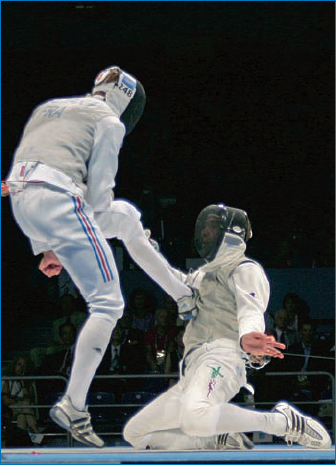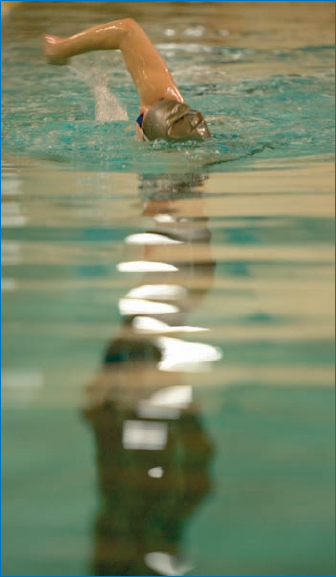
Sports fans and photographers are, individually, two of the most passionate groups of people you'll ever find Combine these two, and you've got a recipe for obsession — a lifetime of getting close to the action, capturing life at its most dramatic, and sharing it with the world.
For a sports photographer focused on shooting an event, there's nothing else in the world that matters more than what he or she is seeing and experiencing at that moment. For the professional photographer, sometimes it means shooting a sport you don't necessarily know well. For example, professional photographers at the Olympic Games often get assigned to two or three different sports every day and must quickly learn the key things to see and shoot, whether it's kayaking, equestrian jumping, javelin throwing, or ski jumping. However, while these photographers may not have a driving passion for some of the individual sports they shoot, they typically became sports photographers because of their passion for sports overall.
Let's look at digital sports photography overall: what it means to shoot sports events, how sports photographers (whether amateur or pro) integrate with an event, and the importance of knowing the sport you're documenting. In addition, this chapter looks at the types of equipment you may be using or will need to use for best results, and it reviews the various sports categories from a photographer's perspective.
If you're an amateur enthusiast or semi-pro, you're probably intent upon shooting a sport you love or one that someone you love loves (such as your spouse or child). And the dramatic moments of victory or defeat are all the more sweet or bitter as a result. Being able to document those moments for posterity in the form of a well-shot photograph is valuable far beyond its ability to create revenue or be published because it will be cherished by those who love not only the sport, but the player.
Even when you know you have taken a nice shot, it may have impact you don't realize, such as when a Swiss fencer won a gold medal that turned out to be the only one won by his country at the Athens 2004 Olympics, as shown in Figure 1-1.
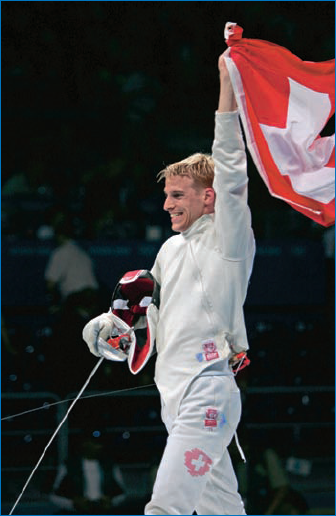
Figure 1-1. Shooting athletes' moments after a big victory often requires quickly changing a camera from an action setting to one that's optimized more for portraiture — or using an alternatecamera set appropriately.
Nonetheless, some digital camera-packing photographers become so involved with the gadgetry of today's technological marvels that they fail to see the action they're intent upon capturing. Then, when they go to edit their images, they hardly remember the sequence of action, often have poorly composed images, and often have missed key moments in the event.
Just like with photographing in the studio, at a wedding, or on location at a news event, photographers capturing sports — professional and amateur alike — must be in tune with their subject matter and involved with what's happening. While the athletes may be (and often are) nearly unaware of the photographers' presence, there is still at least an implied relationship between the player and the shooter.
Often the biggest customers of sports photography are the players who want to be able to see themselves performing on the field of play. And, although they may not be thinking of the photographer during the intensity of competition or athletic endeavor, they undoubtedly know at some level of consciousness that they are being watched. This, in turn, affects how they perform, heightens their adrenaline at least a little, and gives them a bit more of the home court advantage knowing there's an interested audience.
Some athletes may take the opposite tack, shunning publicity or being watched on-or off-camera. For some, participating in a sport, in spite of its inherent public performance factor, is a very private thing, and these athletes find themselves easily distracted by anyone observing them Yet as a photographer, you may still want or need to get shots of these reluctant subjects engaging in their sport, which adds a further bit of challenge to the effort.
Capturing the moment in Figure 1-2 required being discreet while shooting in a weight training facility so as not to disturb athletes while they were training.
The relationship between observer and performer, player and photographer, athlete and spectator is intertwined permanently And you, the photographer, must understand and engage in this relationship in order to create the best images of the player and the event. To do so means understanding how to shoot the event, how to best use the equipment you have, and what to do best with the images you capture.
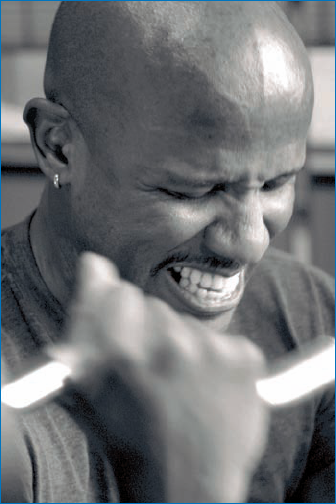
Figure 1-2. Shooting quietly and without distraction requires limiting use of the flash, or not using it all, and often using a longer lens when getting close-ups. This image was shot from about halfway across the room with a 70–200mm, 2.8 lens at ISO 400 at 1/250 second to give it a narrow depth-of-field look.
For most sports, photographers have little, if any, control over their environment. Unlike a studio shoot, or even taking a snapshot of friends, the lighting cannot be controlled, the players cannot be posed, and finding a good spot from which to shoot may be tough. At the most exciting moment of the event, the action you want to shoot may be on the other side of the field, the player may be facing away from you, a zealous fan may jump in front of your lens, or another photographer may suddenly obstruct your view or bump into you.
The photo in Figure 1-3, taken at the Athens 2004 Olympic Games, shows the difficulty that even pro photographers sometimes have in getting a good vantage point to do their work.
Pro photographers often have to fight for the best positions at sporting events At the Olympics, official photographers are given key positions, and hierarchies exist among the ranks. Photographers receive official vests for identification, and a special vest is given to each photography/media organization, allowing those individuals premium positions in front of other photographers.
Still, photographers often have to elbow and wedge their way into a good slot to be able to see athletes receive medals or top performers doing their thing on the field or court Add to that the language barriers and variety of cultures at an event like the Olympic Games, and you suddenly have a group of pros that can become hostile at a moment's notice if they aren't getting the shots they want or need.

Figure 1-3. Finding a good spot, even as an official photographer at the Olympics, can be challenging; comfort often becomes secondary.
One distinguishing characteristic of how pro versus amateur sports photographers shoot is how they anticipate the action. Amateurs typically shoot as things happen — usually with only one camera — and wait for the best moment to try to take a great shot. Pro photographers are ready for anything and shoot almost all the action — even the boring parts. They know they can simply delete or edit out the useless images later Furthermore, they anticipate the action.
In Figure 1-4, for example, I had taken a quick sequence of shots where these Olympic foil fencers were actually trying to keep each other away; however, in the process, the image ended up appearing much more like a malicious act where one was kicking the other in the chest. However, because of the action that preceded this move, I had been able to anticipate that the fencers would execute an action that would be interesting.
If a gold medal is about to be won, pro photographers have an alternate camera ready to go that's been preset for the lighting changes when the team rushes onto the field to celebrate the win; often the settings and lenses needed for capturing celebration shots are different than what might have been needed for the final scoring action.
Of course, you may not be shooting the Olympic Games, and you might not be out on the field with two or three cameras Nonetheless, the concept of anticipation and the principles of sports photography apply to successfully capture great photos, whether you have a fixed-lens, point-and-shoot camera or a high-end SLR (single-lens reflex) camera — meaning it uses detachable, interchangeable lenses and, when you look through the viewfinder, you are looking through the lens. When you're anticipating action, it depends on the capabilities of your camera as to how you can shoot an athletic sequence If your camera can take bursts of shots in rapid succession, you can anticipate when action is just about to take place, hit the button, and let it go (assuming you have your settings, focus, etc correctly adjusted). If your camera is a bit slower, or the number of shots it can buffer in a burst is low, then you may be better off pressing the shutter release one shot at a time. The slower the camera, the more you'll need to hone your anticipatory skills — and you'll also want to know the sport well. So anticipating and getting good shots involves knowing the capabilities and limitations of your equipment, understanding the sport, and composing the shot well. Anticipation is all about being prepared to position yourself to take different types of shots as the phases of sports action and ultimate victory (or defeat) take place.
As a photo enthusiast, you may find yourself limited to being able to shoot from only one seat in the stands, or being very limited in terms of where you can go to take a good photo. This is where equipment can help, at least to a degree, in allowing you to have a closer view with a longer lens, a camera able to shoot good photos in limited light if a flash isn't an option, or the ability to take multiple frames per second to ensure that you catch the action as it takes place.
The photo in Figure 1-5 required me to shoot at a distance, in low light. For this type of shooting, you'll need an SLR with a detachable lens that supports a wide aperture (such as f/2 8) and a high ISO rating. The newer, high-end SLRs allow you to take photos at a high ISO (like 1600 or higher) with a surprisingly small amount of digital noise in the image.
Most often, these options mean buying cameras and accessories that cost more and are more bulky than the simple point-and-shoot models, but if you're truly intent upon getting good photos, you'll have to consider spending the extra money and toting the extra weight.
Note
I return to special issues involved in shooting action shots in the course of addressing specific challenges of different sports in Part II of this book.
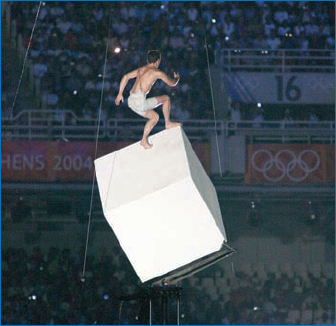
Figure 1-5. Photographing this very athletic performer at the Olympic Games opening ceremonies demanded that I use afast telephoto lens. I shot at an f-stop of 2.8 at all focal lengths in order to get a crisp shot from a long distance.
Obviously, some sports place more demands on your ability to capture high-speed action than others, but these are some basic principles involved in capturing action shots:
Know the sport. Even photographers with only moderately fast cameras can often get good shots if they know what's happening, they make educated guesses as to what might come next in a key competition, and they find the best or most creative vantage points.
Know what your equipment can and can't do. For some action in certain lighting conditions, only an expensive, high-speed SLR with a fast lens (meaning that it can shoot at any focal length at a constant, wide aperture setting such as f/2.8) will suffice; in other instances, you maybe able to use a point-and-shoot and get good results. In any event, practice with your equipment before having to shoot a "moment of truth."
Get as close as possible to where pro photographers locate themselves. Sometimes being close to referees and coaches — as long as you don't get in their way — can provide a great place from which to shoot action shots. I've even shot from the platform of a TV camera before, using a long lens.
Know the shots you need to get, and study them ahead of time. Read major sports magazines, such as Sports Illustrated, and look at the Web for various images. Use Google or Yahoo! to search for images instead of text; the Web is a great resource.
Take more shots than you think you'll need. You can always delete images, but you can't add them!
If you need your camera to catch more stop-action and you can't get the right exposure, shoot a little darker than you normally would. This allows you to increase your shutter speed. You can lighten images in your image-editing package relatively easily.
Don't be afraid to shoot tight, meaning that some parts of the athletes are cut off. This adds drama to your action composition and makes the person seeing the image really feel close to the action.
Ever wonder how the pro sports photographers in Sports Illustrated and other publications get those great shots that you just can't seem to get, even when you're just as close to the action as they are? In part, the answer lies in techniques that I'll be illustrating for you throughout this book. But the other factor behind those spectacular photos involves the equipment those pros are using.
There's no substitute for a high-quality camera to capture the essence of an athlete, and this can be true both in action as well as personal portraits, such as the image in Figure 1-6.
Here, and throughout this book, I'll be sharing insights into the type of equipment that I and other professional sports photographers use to capture those insanely hard-to-grab sports moments to which we all aspire Don't despair if your personal equipment isn't professional quality — this doesn't mean that you can't get professional-quality photographs with some practice You'll find the behind-the-lens insights shared throughout this book are helpful no matter what kind of digital equipment you currently use And the range of equipment options available is enormous.
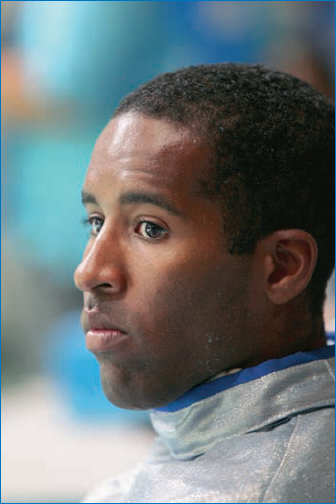
Figure 1-6. U.S. Olympic saber fencing champion Keeth Smart, in a thoughtful moment at the Olympic Games. The Canon 1D Mark II is excellent for capturing high-end sports images, whether they're still, such as this one, or high-speed action.
The camera that I use for shooting fencing and other sports is a Canon 1D Mark II, a top-of-the-line sports and photojournalism camera. It is capable of shooting more than eight frames per second at 8 2 mega-pixels, up to 40 frames without stopping or slowing down. Dozens, if not hundreds, of lenses are available for the camera, and it can shoot at 1/8000 of a second at up to 3200 ISO. If it can be seen, this camera can see it High-end cameras, such as the ones I use, are protected by multiple seals and magnesium bodies that prevent moisture, dust, sand, and other elements from affecting the cameras' performance.
Note
Canon is not the only company making high-quality digital SLRs Nikon also has a line of these professional-grade cameras.
The photo of the French Olympic saber team, shown in Figure 1-7, was taken with a Canon 1D Mark II. I used the camera's ability to shoot more than eight frames per second to capture the team jumping in the air all together, something I couldn't have pulled off as easily with a camera that had shutter-lag. With a point-and-shoot or camera that's not quite as fast, getting images like this will result from really knowing how to anticipate the action or by getting lucky when you hit the shutter release. However, by placing any camera on manual instead of automatic settings, your speed will be optimized, and, consequently, your likelihood of getting spontaneous action shots.
Note
More detailed settings for various cameras and sports are covered in the chapters located in Part II of this book.
Fast, professional cameras are prohibitively expensive for the average amateur and enthusiast photographer; however, we want to address how you can optimize your camera to get the best shots possible, even if they aren't Olympic images. Within the scope of consumer cameras, there is still a large difference between products that will produce decent photos of fast action and ones that won't. And, for many consumer cameras, they've been geared for totally automatic shots taken by someone who really has very little interest in knowing how to set the camera in an optimal way. Yet, many of these cameras are capable of quite a bit more than you might expect if you go to the trouble of understanding how to operate them manually. But this also means knowing how to set the camera for the type of action, light, and sport you're shooting.
For sports, you might think that a point-and-shoot digital camera is often very impractical, and for the high-end professional photographer, it is. However, many consumer photographers — from amateur to avid enthusiast — are finding them very practical for a wide variety of photography. In addition to my high-end SLR equipment, for example, I also carry a Canon point-and-shoot for photo opportunities where it's a pain to drag-out all of my big equipment.
First, the limitations: For shooting fast sports, the biggest problem is that point-and-shoot cameras usually have the greatest degree of shutter-lag, which means that they have that pesky tendency to respond slowly when the shutter release is pressed, making shooting any action sport very difficult. Also, a simple digital camera often does not zoom in very well With a point-and-shoot camera, you cannot interchange lenses, and you usually cannot add a flash Simple digitals can take a long time to record a single image onto the flash card, and they are limited when it comes to sensitivity (often with an ISO limited to 400).
This doesn't mean that you're doomed if a point-and-shoot is what you have; it just means you'll have a harder job getting the shots you want, you need to hone your anticipation skills, and you need to learn to understand the limitations of your particular camera. And don't be fooled Just because the camera has a reasonably high mega-pixel count, such as 5 0 or higher, it doesn't mean the image quality will be great if you still have to use a digital zoom or other technological innovations. Generally, a digital zoom ends up producing poorer quality images.
If you're going to shoot sports, having an SLR camera is desirable. And, if you are using an SLR, the following features are important:
The ability to interchange lenses of various types: wide angle, zoom, telephoto, portrait, and so on
A shooting speed rating of at least four frames per second
A minimum sensitivity rating of ISO 800 or higher
A shutter capable of shooting photos at 1/500 second or faster
For some sports, having a tracking auto-focus is helpful. A tracking auto-focus changes the focus on a moving object without your having to do anything except keep your finger on the focus button (called "AI Servo" in Canon cameras).
A buffer of at least 15 images, meaning that the camera shoots at its maximum speed up to this many shots before it has to stall to download images.
Image stabilization, especially on telephoto lenses (it's less useful on shorter focal lengths); this is an ability in the camera or lens to electronically "steady" itself to capture a clear, non-blurry image even at a slower speed and when the camera is moving or shaking.
If you do have a point-and-shoot camera or are considering buying one, there are some key features to look for if you're going to be shooting sports:
Higher ISO capability (ISO 400 or higher)
A fast shutter speed (at the very least, 1/250 second)
The ability to manually set the ISO, shutter speed, and aperture (f-stop)
The ability to disable the flash
As little shutter-lag as possible (to really determine this, your best bet is to go to a camera store and try out the various cameras)
As broad an optical zoom range as possible
For virtually every sport on the planet, there are great photo opportunities and a nearly infinite number of ways to shoot the game, the action, the players, the spectators, the environment, the officials, the losers, and the winners. No matter what your level of expertise, if you have a desire to photograph sports, there's an open invitation waiting to capture it like no one ever has.
That said, almost nothing is photographed more than sports And the digital revolution has had as great an impact on sports as (and probably more than) any other realm of photography. When Sports Illustrated went completely digital to shoot (and store!) over a half million images at the 2004 Olympics, that decision indicated the dominance of digital photography in sports.
To completely understand digital sports photography, you need to consider where you are going to be working and the impact location has on how you work. You also must try to understand your subjects and their sports, and to determine how you want to capture the action.
Sports are unforgiving to the photographer You must adapt to your environment; it's not going to adapt to you. You must be ready to deal with whatever lighting exists, possibly harsh outdoor conditions, and people moving about quickly — not necessarily in the direction or facing the way you want them to. It means that even if you're a professional, you won't always get the shot you want, and you may miss something you really need You'll swear that you'd be rich if you had a dollar for every great shot you missed, and you'll cherish the times when you actually get the great shots.
You'll shoot far more photos than you'll ever need, which means you'll also need to be prepared for post-production digital photography workflow: Processing, archiving, prioritizing, and presenting images efficiently and effectively will be key to your ability to consistently and successfully execute photo shoots of sports events and figures. The photo in Figure 1-8, for example, is a posed photo. However, the subject, a third-level black belt, was very sensitive to being sure he was positioned and posed correctly to capture the essence of his achievement in martial arts.
It is, then, incumbent upon the photographer to understand what it takes to shoot a specific sport, what various environmental factors will affect the photos, what is important and meaningful in a given sport, what kind of access you'll have to athletes and competition, what the capabilities and limitations are of the equipment available, and what the intended purpose is of the images to ensure the best possible workflow.
Ask yourself these general questions before shooting any sport:
What do I know about this sport and how can I use that knowledge?
What do I need to know in order to understand it well enough to take interesting photos?
Will I be in any danger shooting the sport, such as hanging out of a moving or flying vehicle? What should I do to ensure my safety?.
Here are some location-related questions to consider:
Where should I position myself to take the best shots, and how accessible is that spot? What alternative or other positions should I also consider?
Should I avoid some people or places, such as standing in an end zone or getting in the way of a coach or referee?

Figure 1-8. Even a posed shot can require learning about a sport and working with the athlete to understand what is required to capture the real feeling of the sport and represent it properly.
Consider what you need to know about the athletes and officials.
Do I need any special permission to take photos, or am I prohibited in some way from taking photos?
Will I have access to players before, during, or after the event in order to take some personal photos?
If necessary, will I be able to identify players after the event by looking at photos (especially important for images that will be published or sold)? Do I need to observe or capture any key players?
Consider what you need to know about the location:
Is the activity going to be indoors or outside?
What will the lighting be, and how will that affect my photos?
In this venue, how close can I get to the action?
How physically fit do I need to be to get the best shots (will I be in the water, skiing the back country, or jumping out of a plane)?
Based on the sport and how I plan to get the shots, what limitations are placed on my ability to access equipment, change lenses and flash cards, etc.?
Do I need to consider environmental factors, such as salt water, cold weather, rain, or even crowds of pushy people?.
What equipment you need varies depending on the situation, so consider these points when packing your gear:
Do I need to be able to enlarge the photos? How much? Will they go online or be printed?
What size JPEG files or other formats should I use to optimize my flash card usage but still have images that are large enough for what I need?
Will I be able to use a flash?
Do I know how far I will be from the action?
Obviously, some sports are photographed more than others, and some pro sports are photographed almost exclusively by pro photographers due to limitations placed on photography by professional sports organizations For example, the International Olympic Committee requires significant documentation and application procedures to become an official photographer, and the credentials are stringent and very limited in their availability. Applications must be submitted many months before the games Sports publications and organizations commission all of their photos from pro photographers dedicated to providing a comprehensive service of photographs for the event. These photographers receive privileged access to shoot the events But amateurs and enthusiasts sitting in the stands or on the sidelines at events can still get great photos, even if they aren't going to end up in Sports Illustrated. In fact, the average amateur photographer today has many more opportunities to get their images seen thanks to being able to put images online.
Most pro and big-venue sports events provide comprehensive services for working photographers to be able to review and process images and get them to news agencies and organizations virtually immediately, as seen in Figure 1-9.
However, whether you have an interest in getting on the sidelines of a basketball game in a sports arena, shooting your son's snowboarding competition in harsh winter conditions, or hanging on the side of a mountain rock face to catch your buddy in mid-rappel, you need to consider each sport individually in terms of what it demands of photography.

Figure 1-9. Olympic photographers working in the main media facility, where access is strictly limited to working, credentialed photographers
Consider the general parameters of the sport.
What is the nature of the sport? That is, how is it played, where is it played, and who plays it?.
Is it fast or slow?
Is it performed in a big or a small space?
Is it indoors or outdoors?
What particular environmental factors need to be considered, both for taking photos as well as for protecting equipment?
What lighting are you likely to encounter?
How will the light affect your exposure settings and white balance?
Can you use a flash?
How have others shot the sport — both amateurs and professionals? Is it a sport that is photographed all the time, or is it less common? Is it going to be logistically, bureaucratically, or environmentally challenging to shoot?
What are you trying to capture? Action? Faces and personalities? Drama?
Are you just shooting for fun, or for a purpose?
How important is it for you to be able to specifically identify each player?
Will other people need to be able to access that information (for example, to be able to find themselves in an online photo database)?
What permission or credentials do you need to shoot the event?
Do you need model releases?
This may sound like lots to think about if your plan is to simply take snapshots of a 10-year-old's soccer game, and for that, it probably is However, depending on what sport you plan to shoot and what you intend to do with the photos, at least some, if not all, of these points are worth taking into consideration.
In this book sports are divided broadly into five categories: outdoor field and court sports; outdoor recreation and competition; indoor competition; extreme/adventure sports; and specialized sports. While there may be some overlap among these — meaning, for example, that a given sport could fit into more than one category — this breakdown is logically tied not only by the type of sport and where it's pursued, but also how it's photographed.
Paid photographers may have better equipment and often get premium positioning, but something that they do that you can also employ in sports shoots is planning. The kinds of factors touched on in the previous sections all must be considered ahead of time Preparing your shoot and equipment before the event will ensure a much higher percentage of good photos than if you go into the event cold and attempt to "shoot from the hip." Years ago, when I was a scuba instructor in the crystal-clear waters of the Gulf of Mexico, I always taught students that you "plan your dive and dive your plan" to ensure safety and success in each dive Likewise, for sports photo shoots, always remember: Plan your shoot, and shoot your plan.
Although this planning sounds as if it may limit your ability to capture candid moments in sports, it actually has the opposite effect. Because you are more confident about the basic shots you're going to get, capturing the unexpected ones is that much easier.
I want to briefly tell you about some specific areas of sports photography. Later in the book I cover them more deeply and specifically to help you shoot them creatively and professionally. Although it's impractical to cover every sport, those included are grouped into five categories that, for photography purposes, have general application.
This category includes baseball, soccer, football, lacrosse, rugby, tennis, track and field, and field hockey.
Outdoor field and court sports are characterized by bigger crowds, changing weather and light, and the challenge of shooting action that may be taking place across a large distance Photographers who shoot these kinds of sports professionally often use very long (and expensive!) telephoto lenses along with high-speed cameras Of course, if you're shooting an amateur and/or kids' event, you may be able to get close to the action for some great shots, such as the one in Figure 1-10.

Figure 1-10. This photo by photographer Adam Hardtke captures the drama and action of Little League baseball. Shot at 1/2000 of a second, a digital SLR is essential in catching stop-action images: © Adam Hardtke.
You may even need to be shooting in rain or snow, which means that your equipment needs to be weatherproofed or protected Professional events for outdoor field and court sports are often highly controlled by officials and sports organizers, so gaining access as a photographer may be difficult and daunting, requiring press credentials from a qualified news organization.
This category includes auto and motorcycle racing, golf, cycling, sailing, water skiing, boat racing, jetskiing, snow skiing and snowboarding, canoeing and kayaking, skateboarding, and rollerblading.
Outdoor recreation and competition are some of the most exciting sports and events to photograph, but they can be the most challenging and equipment-intensive due to the often rough and/or harsh conditions, such as water, cold, heat, and snow. Inclement weather is also a factor; however, you're probably more likely to shoot a football game in a rainstorm than you are water skiing, sailing, jet skiing, or skateboarding But you still need to be sure that your gear is protected anytime you're close to water, even if you're far from the action shown in Figure 1-11.
These types of sports sometimes require you to be quite far from the action, such as with water skiing or sailing events This affects the kind of equipment you use. Also, for very high-speed sports, such as motor racing, you must consider positioning as well as the equipment able to capture the action in a loud, often crowded, and potentially hazardous setting.
This cateorgy includes basketball, ice hockey, gymnastics, martial arts, racquetball, fencing, table tennis, figure skating, and weightlifting and bodybuilding.
As much as weather is a factor in outdoor sports and recreation, lighting is the biggest challenge when it comes to indoor sports. Rarely are sports halls or arenas lit adequately or evenly, and inconsistent lighting can wreak havoc with a camera's white balance. And don't count on being able to use a flash, because they're rarely permitted when you're close enough for them to be useful.
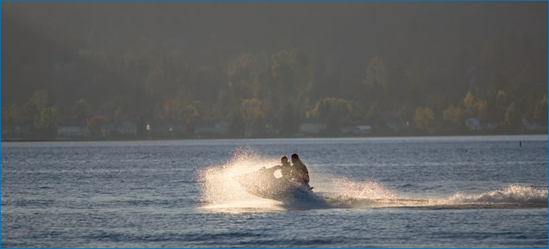
Figure 1-11. Jet skiing can be spectacular to shoot late in the day during sunny weather. I shot this image directly into the sunlight on Lake Sammamish near Seattle at a shutter speed of 1/8000 second to create a silhouette effect with water spray.
Crowds and positioning also get more critical indoors when you have to move around in a sports facility, navigating referees, scoreboards, equipment, players, and bleachers. These challenges, however, are somewhat offset by being able to shoot where weather isn't a factor and lighting is usually more consistent.
This category includes hang gliding, sky diving, parasailing, snowmobiling, rock and mountain climbing, drag racing, and back-country skiing.
Although you may be happy to carry a small point-and-shoot camera for extreme sports because it's so light and portable, these are some of the most challenging activities to shoot with even the most advanced equipment. Cameras must be protected from the elements and rough terrain or conditions, yet accessible with minimal hassle. You may not be able to change flash cards or back up images easily (Change a CompactFlash card while in free fall? Not likely!), power may be unavailable for charging batteries, and it is completely up to you to adapt to your environment, not the other way around. This means you'll be best off taking only what you specifically need, but be sure that you have the best equipment for the job and be ready for unexpected opportunities.
The photo in Figure 1-12 by photographer Will Wissman taken in Alta, Utah, required packing in camera equipment to difficult, deep snow locations.
Some sports in this category include swimming and diving, scuba diving and snorkeling, indoor arena sports (such as football, soccer, baseball), and equestrian events.
This category may require special equipment, such as for underwater photography; a different approach to traditional sports, such as shooting soccer indoors; or factors not found in other sports that can directly affect photography, such as live animals. Each of these areas involves special planning and diverges from how you might typically approach a sports photography endeavor Even swimming can be tough to shoot in a humid, wet environment where you need to get close to the subject as in the shot in Figure 1-13 of a recreational early-morning swimmer.
The good news is that photographers who become adept at any of these areas, which by definition are less common than most sports, have a good opportunity of getting closer to the sport and getting to shoot high-end events.
Shooting sports combines a variety of factors, including your knowledge of and access to various sports, the kind of equipment you're using to capture the action, and the environment in which you'll be shooting. As a photographer, how you compose and process the photos you take is equally important, as well, to ensure you not only get the shots but that the images you capture are the best quality possible.
Digital cameras come in many shapes and sizes, largely divided between SLR (single-lens reflex) and point-and-shoot models While the point-and-shoot camera is small and nimble, the SLR is more versatile in its ability to get fast-action shots and use interchangeable lenses. Depending on what kind of equipment you're using, you need to know how to optimally set and control it to get the best shots possible of the sport you're after. This will give you the best chance of anticipating the action that's sure to come. Unlike posed or studio photography, in sports you may only get one shot at that great moment, so you'll want to be prepared.
Understanding where you're going to be shooting, what equipment you have, your access, and other factors are all key factors in getting the best shots.

